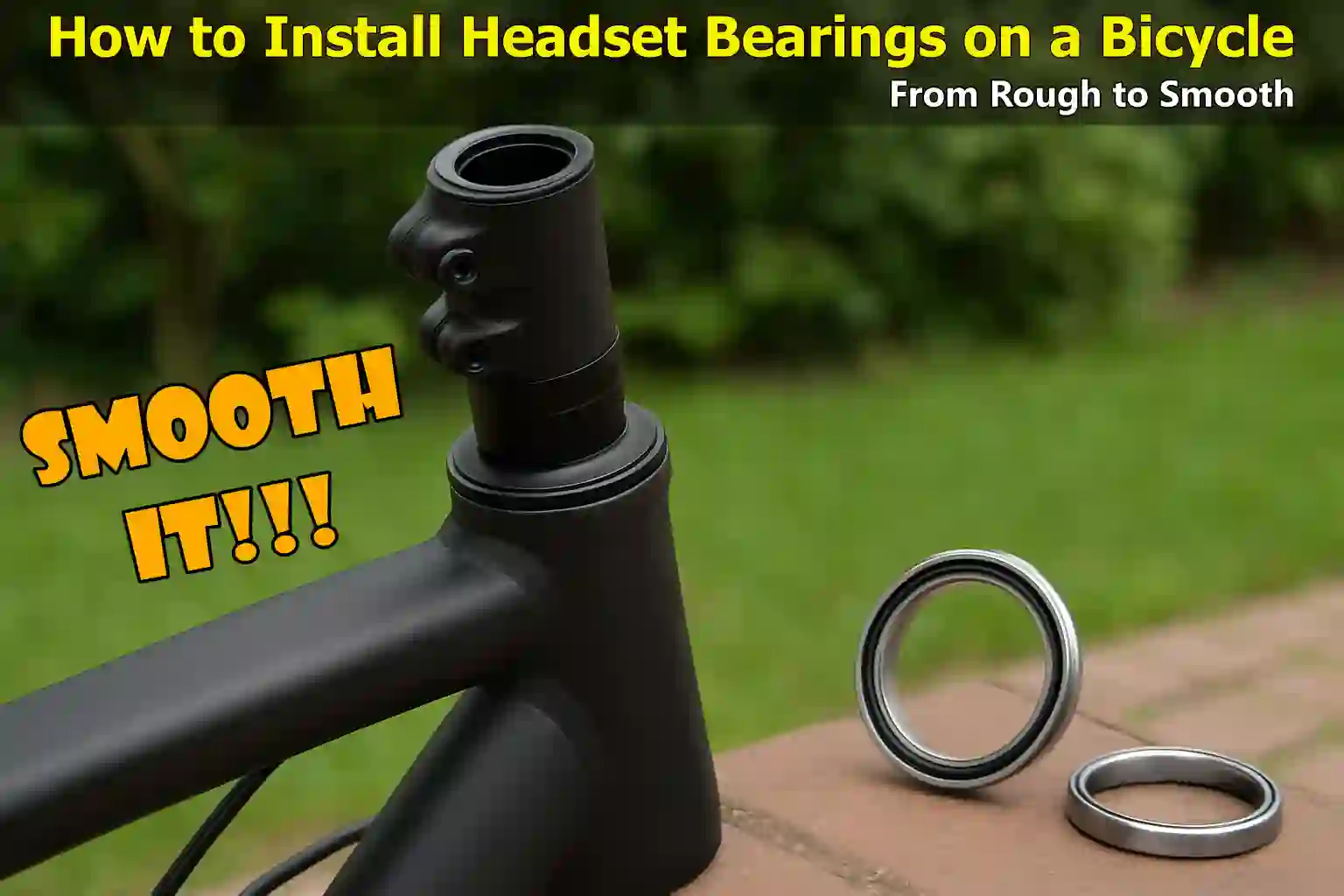Written By: Jonathan
Fact Checked By: Caroline Dezendorf
Reviewed By: Matt Tanner
If you really feel that you actually feeling the bicycle’s handlebar stiff, shaky or making weird grinding noises when you turn, then the chances are your headset bearings actually needs fresh installation.
It is actually responsible for smooth and stable steering, just like a joint in your body: so whey they are really clean, properly greased and correctly installed then everything moves effortlessly.
But you should not neglect as worn out or incorrectly installed headset bearings can cause the jerky turns, misalignment and even damage your frame or fork as well.
This is why in this guide we have actually covered that How to Install Headset Bearings on a Bicycle, so that you can install them with ideal precision.
Tools
| Tool | Purpose / Use |
|---|---|
| Allen Wrenches (Hex Keys) | It is great for tightening the top cap and stem bolts and usually you will need of 4mm, 5mm, or 6mm. |
| Grease | It is actually used to reduce friction and prevent corrosion on bearings and contact surfaces. |
| Clean Rag or Cloth | Plus, it is necessary for cleaning the head tube, bearings, and fork steerer before installation. |
| Top Cap & Bolt | Yes, these are really needed to preload the headset bearings before tightening the stem. |
| Spacers (Optional) | This is truly optional but it can be Used to adjust handlebar height on the steerer tube if needed. |
How to Install Headset Bearings on a Bicycle: Integrated & Threadless Both
It is really necessary to install the headset bearings in the correct way as then it will ensure the smooth steering and long-term performance of your bicycle.
Not only this, yes process also vary depending on the type of headset your bicycle uses, as common types of headsets are: Integrated & Threadless External or Semi-Integrated.
1. How to Install Bearings for Integrated Headsets
The integrated headsets are ideally designed in a way that the bearings sit directly inside the cups of the bicycle frame, as these headsets are usually found on the modern road bicycles, gravel bicycles and many carbon fiber frames as well.
Also, Integrated headsets actually allow bearings to be installed directly into molded frame seats; as traditional setups really require a cup-press-fit followed by careful bearing installation.[¹]
1. Place the Bearings into the Bearing Seats
As each bearings has a specific kind of orientation, as most of the integrated headset bearings are angular contact cartridge bearings.
That’s why these usually have an angled or chamfered side, which is why it must face in inward direction toward the frame.
Not only this, the flat side should be faces in the outward direction, and placing the bearing in the wrong way can literally cause the poor contact and premature wear as well.
2. Check That the Bearings Are Seated In a Proper Way
Now, you have to gently press the bearings into the top and bottom bearing should seats of the frame as well.
So, just use your fingers to make sur ethe are flush and evenly seated as well, and if they are rock or don’t sit flat then you have to remove and recheck for their orientation and cleanliness again.
3. Seat the Fork’s Crown Race
So, basically the crown race is the metallic ring that should sits on the base of the fork’s steerer tube and that provides a smooth surface for the lower bearings as well.
As well as, you have to make sure that is is properly clean and fully seated as well.
And if you are installing a new crown race then you have to use a crown race setter tool for even pressure, as a loose or uneven race will again create the steering play as well.
4. Insert the Fork Through the Head Tube
Now, you actually have to be really careful and then slide the fork steerer tube up through the headset, so it passes through both the lower and the upper headset bearings as well.
Plus, just hold it in place so that to prevent it from dropping or damaging the bearings as well.
5. Install the Compression System
Not only this, now you have to install the compression ring which is also known as split ring as well, which sits on the top of the upper bearing and that actually helps preload the system.
And then just place the top cover over it, as this keeps dirt and water out and it provides a smooth finish as well.
Along with this, you have to add any required spacers above or below the stem which truly depends on your bicycle’s fit preferences.
6. Attach the Stem and Preload the Headset
Just slide the stem onto the steerer tube, and then tighten the top cap bolt to preload the bearings usually around 4 to 5 Nm torque or until snug with no play noticed.
And then you just you have to tighten the stem bolts to lock the fork in the position and always tighten the top cap before clamping the stem bolts.
2. How to Install Bearings for Threadless External or Semi-Integrated Headsets
So, unlike the integrated headsets, these systems actually requires bearing cups to be pressed into the frame first and then the bearings are actually placed inside it.
As these are actually more common on the older bicycles, mountain bicycles and aluminum frames as well.
1. Press the Bearing Cups Into the Frame
Now, start by applying a thin layer of anti-seize compound or grease to the inside of the head tube and the outside of the bearing cups as well.
Then you have to use a headset press tool to press the upper and lower cups into the head tube as well.
This literally ensures they are straight, level and fully inserted and you should never hammer them in: as it can bend the frame or damage the cups as well.
2. Grease and Insert the Bearings
Just apply high-quality waterproof grease inside the cups, then gently place the bearings into the cups and again you have to ensure the correct orientation as well: as the angled side typically faces inward direction toward the frame.
3. Install the Crown Race on the Fork
And with the integrated headsets, the crown race must be properly fitted to the base of the fork’s steerer tube.
As it fits in a tight way, that’s why you have to use a crown race installer tool, so do not force it with a hammer: as uneven pressure can literally crack carbon steerer tubes or damage the fork as well.
4. Insert the Fork Through the Head Tube
Now, slide the fork up through the lower bearing and out the top of the frame, so just hold it securely in a place while installing the rest of the components so that you can prevent it from falling or misaligning the bearings.
5. Add Compression Ring, Top Cover and Spacers
So, now you have to install the compression ring on the top of the upper bearing, followed by the top cap cover.
Now, you have to place the spacers as needed to adjust the bar height and fit, just like in the integrated systems.
6. Install the Stem and Adjust Preload
Now, you have to place the stem on the steerer tube, so jus insert the top cap and then gently tighten the top cap bolt to apply the pressure on the system.
This preload actually removes any gaps and it ensures smooth bearing contact, and then you have to align the stem with the front wheel and tighten the stem clamp bolts to manufacturer torque specifications usually around 5 to 6 Nm.
Read More:
Conclusion On How to Install Headset Bearings on a Bicycle
These bearings may be really small thing, but their role in controlling how your bicycle handles is truly massive.
In fact, even slight misalignment or lack of preload that can really affect your ride comfort, responsiveness and long-term durability of components as well.
So, that’s all about this guide on How to Install Headset Bearings on a Bicycle, and you can comment down below your thoughts or questions as well.
Frequently Asked Questions
Q1. Do I need to replace the crown race when replacing bearings?
Answer: It is not always necessary, but it is highly recommended as well, as a worn crown race may not seat properly with new bearings that then leads to the creaking, looseness or uneven wear as well. As well as, many new headset bearing kits come with a matching crown race as well so that to ensure the optimal performance as well.
References:
[1] Hope Tech. Headset Technical Guide
https://www.hopetech.com/_repository/1/documents/HOPEHEADSETS2011Web.pdf
Jonathan, the passionate owner of Bicycle Time, brings a lifelong love for bikes and automotive craftsmanship, that reflects into every corner of the shop. With deep passion in both cycling and automotive accessories, Jonathan is more than just an expert.

